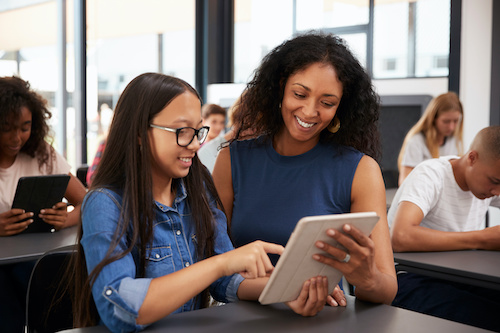Key points:
- As technology evolves, it presents exciting learning opportunities
- Learn more about K-12 Tech Innovation News
- Discover Technology Tools for Teaching and Learning
New technologies are revolutionizing K-12 teaching and learning, ushering in an era of unprecedented possibilities. From innovative learning management systems to interactive whiteboards and adaptive educational software, these tools are reshaping traditional classrooms.
Augmented and virtual reality applications provide immersive learning experiences, while online collaboration platforms connect students and educators globally. Artificial intelligence-driven tools personalize instruction, addressing individual learning needs. As news of these successful tech tool pilots spreads via K-12 tech innovation news, more schools and districts can explore emerging strategies and ideas.
As technology continues to evolve, it presents exciting opportunities to enhance engagement, personalize learning, and equip students with the skills needed for a rapidly advancing future. New technologies will have a transformative impact on the landscape of K-12 education.
What are the new technologies in education?
New technologies used in education are reshaping traditional teaching models. Interactive whiteboards, augmented reality, and virtual reality applications transform classrooms into dynamic, immersive spaces. Adaptive learning platforms utilize artificial intelligence to personalize instruction based on individual student progress. Educational apps, virtual simulations, and online collaboration tools provide diverse and engaging learning experiences.
Additionally, the Internet of Things (IoT) is influencing education through smart devices, creating connected learning environments. Robotics and coding tools introduce students to hands-on STEM learning. Cloud computing enhances accessibility to resources, fostering collaborative projects.
As these technologies evolve, they promise to revolutionize K-12 education, offering innovative approaches to teaching and preparing students for the challenges of the digital age.
What are 3 benefits of using technology in education?
The integration of technology in K-12 education yields several benefits, transforming traditional learning environments.
1. Technology enhances engagement and interactivity. Interactive whiteboards, educational software, and multimedia resources are examples of technologies that improve student learning as they make lessons dynamic and capture students’ attention, fostering a more participatory learning experience.
2. Technology promotes personalized learning. Adaptive learning platforms and educational apps tailor instruction to individual student needs, addressing diverse learning styles and paces. This customization nurtures a more efficient and effective learning process, ensuring that students grasp concepts at their own pace.
3. Technology prepares students for the future by cultivating essential 21st-century skills. Digital literacy, critical thinking, problem-solving, and collaboration are inherent in using educational technologies. Students become familiar with tools and platforms that mirror the technological landscape of the workforce, making them more adept and adaptable in navigating the challenges of a rapidly evolving, technology-driven world.
These benefits collectively contribute to creating a more engaging, efficient, and future-ready educational experience for K-12 students.
What are the emerging technologies in 2024?
Emerging technologies are poised to revolutionize K-12 education, offering innovative ways to engage students and enhance learning outcomes.
Virtual and augmented reality applications bring immersive, hands-on experiences to classrooms, making abstract concepts tangible. Artificial intelligence is increasingly used for personalized learning, tailoring instruction to individual student needs. Gamification and interactive learning platforms introduce elements of play to make lessons more engaging.
Moreover, collaborative tools and virtual classrooms facilitate global connectivity, allowing students to interact with peers worldwide. Robotics and coding tools are fostering hands-on STEM education, preparing students for future careers.
As technology evolves, the impact of emerging technologies in education will be felt across classrooms, schools, and districts. These emerging tools promise to create dynamic, inclusive, and future-ready educational environments, transforming the way students learn and educators teach in the K-12 sector.
How can technology improve education?
Technology can significantly enhance K-12 education by providing dynamic technology tools for teaching and learning that cater to diverse learning needs.
Firstly, it fosters personalized learning through adaptive technologies, tailoring instruction to individual student strengths and weaknesses. Secondly, it facilitates interactive and engaging lessons, utilizing multimedia resources, educational apps, and interactive whiteboards to make learning more enjoyable and effective. Thirdly, technology promotes collaboration and connectivity, connecting students globally through online platforms, fostering teamwork and cultural awareness. Fourthly, it equips students with essential 21st-century skills, including digital literacy and critical thinking, preparing them for an increasingly technology-driven world. Finally, technology streamlines administrative tasks, enabling educators to focus more on individualized instruction.
Collectively, these advancements contribute to creating a more inclusive, interactive, and future-ready educational landscape in K-12 settings.
Conclusion
Advocate for edtech integration, support teacher training, and stay informed on emerging trends. Stakeholders should collaborate to ensure K-12 teaching becomes dynamic, engaging, and tailored to individual student needs, preparing them for success in the evolving digital landscape.
- Friday 5: Virtual field trips - April 26, 2024
- Google, MIT RAISE launch no-cost AI training course for teachers - April 26, 2024
- 4 ways to support work-based learning - April 23, 2024

